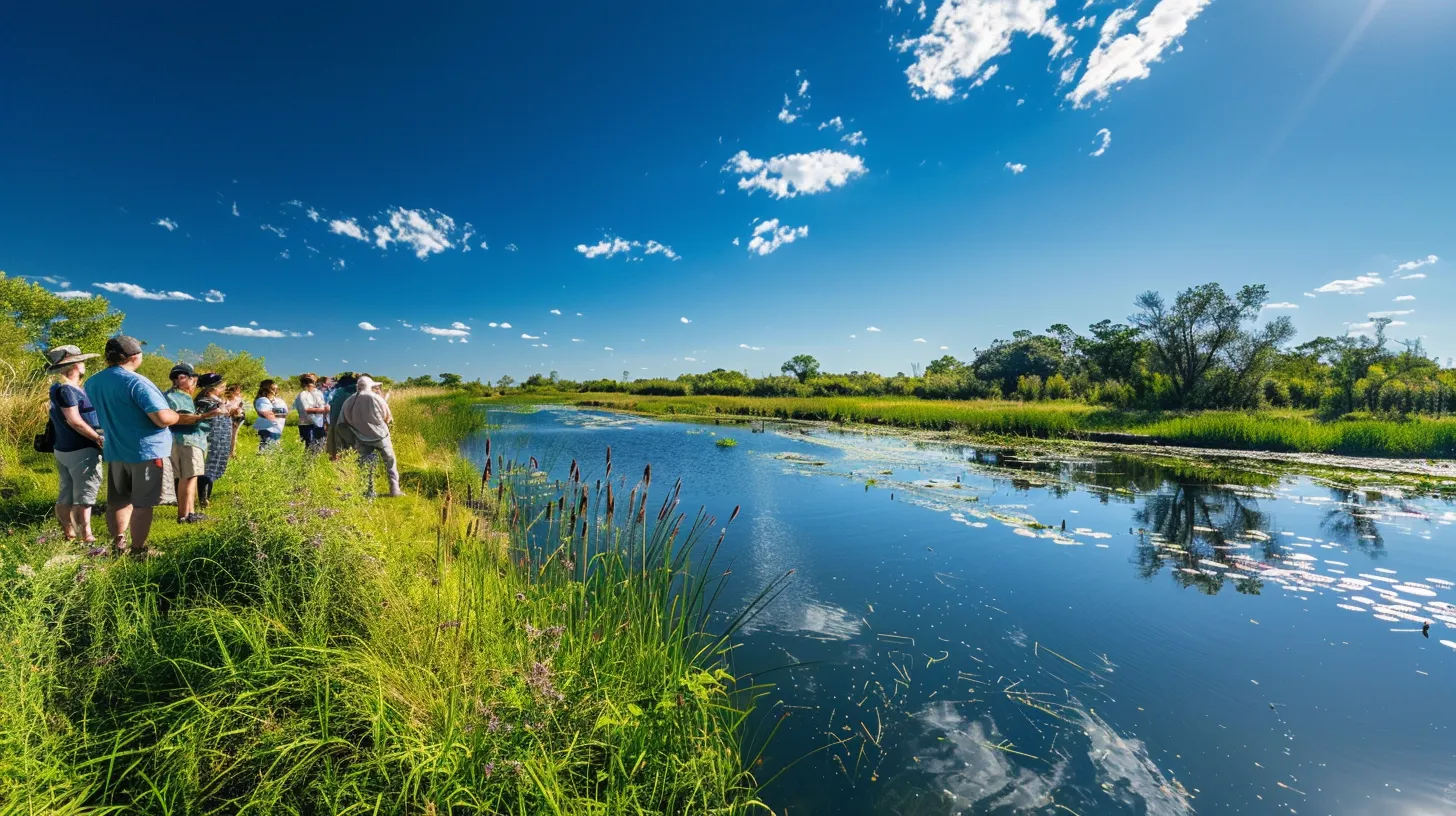Navigating the wetlands permitting process can be a significant challenge for developers, often leading to delays and frustrations. Understanding the regulatory framework and the steps required for environmental permitting is crucial for success. This blog post will guide readers through the wetlands permitting process, detailing how to initiate it, engage with stakeholders, and assess potential impacts. By addressing these key areas, readers will gain clarity on a complex topic, ultimately streamlining their development projects and preventing costly setbacks.
Key Takeaways
- Understanding wetlands is essential for compliance with environmental regulations during development projects
- Engaging specialists can streamline the wetlands permitting process and enhance regulatory compliance
- Comprehensive environmental assessments are critical for identifying potential impacts on wetland ecosystems
- Effective communication with stakeholders fosters transparency and trust in the permitting process
- Strategic mitigation plans are vital for offsetting impacts and ensuring wetland sustainability
Understanding the Wetlands Permitting Process for Development Projects

Wetlands are an essential part of Utah’s natural landscape, particularly along the Wasatch Front, where they provide numerous environmental benefits and play a crucial role in the region’s ecosystem. From the Great Salt Lake’s wetlands to marshes near Utah Lake and smaller riparian wetlands across the foothills, these areas are vital in maintaining biodiversity, acting as natural water filters, and offering flood protection to local communities. For developers, understanding the wetlands permitting process is not just a regulatory requirement—it’s an essential step in ensuring long-term project sustainability and environmental stewardship.
This guide provides a localized overview of wetlands in Utah, their ecological significance, and the permitting process required to successfully navigate development projects while ensuring compliance with federal, state, and local environmental regulations.
Defining Wetlands and Their Local Importance
Wetlands are areas where water saturation is the primary factor affecting soil development, vegetation, and wildlife. These include marshes, swamps, and bogs that can be permanently or seasonally inundated. Along the Wasatch Front, key wetland areas include:
- The Great Salt Lake Wetlands: Among Utah’s most extensive wetlands, these areas provide critical habitat for millions of migratory birds, including species that rely on them as part of the Pacific Flyway.
- Utah Lake Wetlands: Found on the eastern and southern shores of the lake, these wetlands are vital for local fish, amphibians, and other wildlife.
- Jordan River Riparian Areas: These wetlands provide flood control and water filtration services, making them crucial to the Wasatch Front’s water management system.
These wetlands protect the region by absorbing excess water during storms, reducing flooding risks, and filtering pollutants before they reach larger bodies of water. They also serve as critical habitats for diverse wildlife, supporting biodiversity while offering recreational and economic benefits through birdwatching, hunting, and fishing.
The Wetlands Permitting Process in Utah
Developing near or within a wetland area along the Wasatch Front involves a complex permitting process that ensures environmental compliance and mitigates adverse impacts. The following outlines the key steps:
1. Wetland Identification and Delineation
- Developers must first identify whether the project site contains wetlands subject to protection under the Clean Water Act (CWA).
- A wetland delineation study involves on-site investigations by qualified environmental consultants to assess soil conditions, vegetation, and hydrology.
- In Utah, the U.S. Army Corps of Engineers (USACE) oversees the jurisdictional determination to confirm whether a wetland area falls under federal protection.
2. Regulatory Review and Agency Coordination
- Projects impacting wetlands typically require coordination with multiple agencies, including:
- U.S. Army Corps of Engineers (Section 404 Permits): Governs activities involving the discharge of dredged or fill materials into wetlands.
- Utah Division of Water Quality (401 Water Quality Certification): Ensures that projects meet state water quality standards.
- Local Governments: Many cities along the Wasatch Front have specific wetland ordinances to protect sensitive areas.
- U.S. Army Corps of Engineers (Section 404 Permits): Governs activities involving the discharge of dredged or fill materials into wetlands.
- Utah Division of Water Quality (401 Water Quality Certification): Ensures that projects meet state water quality standards.
- Local Governments: Many cities along the Wasatch Front have specific wetland ordinances to protect sensitive areas.
3. Preparing and Submitting a Permit Application
- Developers must provide comprehensive documentation, including site plans, wetland delineation reports, and proposed mitigation measures.
- Applications for Section 404 permits require a description of the project’s purpose, potential impacts on wetlands, and steps to minimize or avoid damage.
4. Mitigation Requirements
- When wetland impacts are unavoidable, mitigation is typically required to compensate for lost wetland functions. Common mitigation strategies in Utah include:
- Wetland Restoration: Restoring degraded wetlands to their natural condition.
- Wetland Creation: Constructing new wetlands to replace those impacted by development.
- Wetland Banking: Purchasing credits from a wetland mitigation bank approved by state and federal agencies.
- Wetland Restoration: Restoring degraded wetlands to their natural condition.
- Wetland Creation: Constructing new wetlands to replace those impacted by development.
- Wetland Banking: Purchasing credits from a wetland mitigation bank approved by state and federal agencies.
The Bear River Migratory Bird Refuge Mitigation Bank and other local banks offer mitigation opportunities for developers in Utah.
5. Public Comment and Review Period
- Many wetland permits, particularly those with significant impacts, require a public review period where community stakeholders can submit feedback.
- Developers should be prepared to address concerns raised by environmental organizations, local governments, and residents.
6. Permit Approval and Conditions
- The USACE will issue a permit upon review if the project meets regulatory standards and includes sufficient mitigation.
- Permits often come with specific conditions, such as monitoring requirements, to ensure that wetland functions are preserved or restored over time.
Challenges Developers Face Along the Wasatch Front
Wetlands along the Wasatch Front present unique challenges due to seasonal water fluctuations, urban development pressures, and proximity to sensitive habitats. Common issues include:
- Seasonal Inundation: Wetlands fed by snowmelt or spring runoff can be difficult to delineate accurately, requiring careful planning for seasonal variations.
- Urban Encroachment: Rapid growth in cities like Salt Lake City, Provo, and Ogden increases the likelihood of wetland disturbances, necessitating proactive mitigation planning.
- Protected Species: Certain wetlands are home to federally protected species, such as the Least Chub and Bonneville Cutthroat Trout, adding layer of regulatory oversight.
Ensuring Compliance and Success in Wetland Permitting
Working with an experienced civil engineering and environmental consulting firm is essential to successfully navigate the wetlands permitting process in Utah. Anderson Engineering offers:
- Wetland Delineation and Reporting: Conducting detailed field investigations and coordinating with regulatory agencies.
- Permit Application Preparation: Compiling required documentation and ensuring compliance with federal, state, and local regulations.
- Mitigation Planning and Design: Developing effective solutions to minimize project delays and environmental impacts.
- Construction Monitoring: Ensuring ongoing compliance throughout project development.
Key Takeaways for Developers
- Start Early: Wetland permitting can be a lengthy process. Engaging early with agencies like the USACE and the Utah Division of Water Quality can prevent delays.
- Hire Experts: Local firms familiar with the Wasatch Front’s wetlands can anticipate challenges and navigate complex regulations more efficiently.
- Consider Mitigation Costs: Budget for potential mitigation measures to avoid unexpected expenses during the project’s permitting phase.
Understanding and respecting wetlands is crucial to achieving regulatory compliance and long-term project success for development projects along Utah’s Wasatch Front. Schedule a consultation with Anderson Engineering to discuss your project’s wetland permitting needs and get expert guidance through every step of the process.
Defining Wetlands and Their Environmental Significance
Wetlands are permanently or seasonally saturated with water, resulting in distinct ecosystems characterized by hydric soils and specific plant communities. These ecosystems serve as critical habitats for diverse wildlife and provide essential ecosystem services such as water filtration, flood control, and carbon sequestration, ultimately aiding climate resilience. Understanding the ecological significance of wetlands is vital for development projects, as maintaining their integrity is crucial for environmental health and compliance with local and federal regulations.
Overview of the Wetlands Permitting Process
The wetlands permitting process is critical for development projects, ensuring that any activity affecting wetland areas complies with legal and environmental standards. This process typically involves steps, including identifying wetland boundaries, assessing potential impacts, and acquiring necessary permits from relevant local, state, or federal authorities. Engaging with specialists during this stage can significantly streamline the process, minimizing delays and enhancing compliance with environmental regulations:
- Identify wetland boundaries and ecological significance.
- Assess the potential impacts of the proposed development.
- Obtain necessary permits from local and federal agencies.
Navigating the wetlands permitting process reveals the challenges developers face in conservation. Understanding the regulatory framework can also guide project success despite strict compliance.
Identifying the Regulatory Framework for Wetland Permitting

Understanding the regulatory framework for wetlands permitting is essential for effective project planning and compliance. This involves reviewing federal regulations affecting wetlands, exploring state-level rules and guidelines, and understanding local ordinances related to wetlands management. These aspects provide vital insights that guide developers in ensuring their projects align with environmental standards and legal requirements.
Reviewing Federal Regulations Affecting Wetlands
Federal regulations governing wetlands, primarily under the Clean Water Act (CWA), establish standards that protect these vital ecosystems from degradation caused by development activities. The U.S. Army Corps of Engineers and the Environmental Protection Agency play significant roles in enforcing these regulations, requiring developers to secure permits and demonstrate that their projects will minimize adverse impacts on wetland areas. Understanding these federal requirements allows project managers to navigate the permitting process more effectively, ensuring compliance and enhancing project sustainability.
Exploring State-Level Regulations and Guidelines
State-level regulations play a crucial role in wetlands permitting, complementing federal guidelines while addressing regional environmental needs. Each state has its own set of laws and agencies responsible for wetlands management, which can significantly influence the permitting process. For example, certain states may require additional impact assessments or impose stricter standards than those mandated federally, emphasizing the importance of developers thoroughly understanding local regulations to ensure compliance and avoid potential project delays.
Understanding Local Ordinances Related to Wetlands
Local ordinances play a significant role in wetlands permitting, often imposing regulations beyond federal and state requirements. Each municipality may have distinct wetland protection and development rules, including specific setbacks, buffer zones, and permitted activities. Developers must engage with local authorities early in their project planning to ensure compliance with these ordinances, as failure to do so can lead to project delays or legal challenges.
With the regulations clear, the path forward emerges. It is time to take the first steps in the wetlands permitting process, which demands careful attention and resolve.
Steps to Initiate the Wetlands Permitting Process

Project developers must conduct a thorough environmental assessment to effectively initiate the wetlands permitting process and evaluate potential impacts on wetland areas. Then, they must prepare the required documentation to demonstrate compliance with regulations. Finally, they must submit the permit application to relevant authorities to ensure adherence to necessary guidelines and advance the project in alignment with environmental standards.
Conducting an Environmental Assessment
Conducting an environmental assessment is a critical first step in the wetlands permitting process, as it identifies potential impacts of development activities on wetland ecosystems. This assessment typically involves evaluating the site’s ecological characteristics, determining the presence of sensitive species, and analyzing how the proposed project may alter water quality or flow. Engaging environmental specialists during this phase can enhance the accuracy of the assessment and facilitate compliance with regulatory requirements:
- Identify ecologically sensitive areas within the development site.
- Evaluate potential impacts on water quality, habitat, and biodiversity.
- Consult with regulatory agencies early to align with compliance needs.
Preparing the Required Documentation
Preparing the required documentation is essential for navigating the wetlands permitting process. This documentation typically includes detailed project proposals, impact assessments, and mitigation plans demonstrating how the project will adhere to local and federal regulations. By compiling precise and comprehensive materials, developers can effectively showcase their commitment to environmental standards and facilitate timely permit approvals:
Submitting the Permit Application
Submitting the permit application is a pivotal step in the wetlands permitting process for development projects. Developers must ensure that all required documentation is complete and accurately reflects the project’s potential impacts on wetland ecosystems. Engaging with regulatory agencies before submission can help clarify specific requirements, ultimately expediting the permit approval process and ensuring compliance with federal, state, and local regulations.
Once the initial steps are set, attention turns to those who will be affected. Engaging stakeholders and public agencies is essential for success.
Engaging Stakeholders and Public Agencies

Engaging stakeholders and public agencies is crucial in the wetlands permitting process for projects. Identifying key stakeholders, such as local communities and environmental groups, fosters collaboration. Understanding the role of public agencies ensures compliance with regulations while effectively communicating project plans to the community and promotes transparency and trust. These elements are essential for successful project development and environmental stewardship.
Identifying Key Stakeholders in the Permitting Process
Identifying key wetland permitting stakeholders is essential to ensure a successful development project aligned with environmental standards. Stakeholders typically include local communities, environmental advocacy groups, regulatory agencies, and project developers. Engaging these parties early in the process fosters collaboration and facilitates transparent communication, thereby addressing concerns about potential impacts on wetlands and promoting a more sustainable approach to project development:
Understanding the Role of Public Agencies
Public agencies play a crucial role in the wetlands permitting process by enforcing compliance with environmental regulations and ensuring that development projects do not compromise these sensitive ecosystems. Agencies such as the U.S. Army Corps of Engineers and local environmental departments assess permit applications, scrutinizing potential impacts on wetlands and establishing conditions that help preserve ecological balance. Engaging with these agencies early in the project planning allows developers to clarify requirements and align their proposals with regulatory expectations, ultimately facilitating smoother approvals and promoting sustainable development practices.
Communicating Project Plans to the Community
Effective communication of project plans to the community is essential for gaining support and fostering trust during the wetlands permitting process. Developers should provide clear, concise information about the project’s objectives, timelines, and potential environmental impacts, actively encouraging feedback from local residents and interest groups. By facilitating open dialogue through community meetings or informational sessions, project managers can address concerns and demonstrate a commitment to transparency, ultimately enhancing stakeholder engagement and promoting a cooperative approach to environmental stewardship.
The voices of the stakeholders and public agencies echoed with concern. Now, the focus turns to the wetlands, where the true impact of our actions awaits measurement.
Assessing Potential Impacts on Wetlands

Assessing potential impacts on wetlands begins with evaluating the ecological implications of the proposed development project. This includes conducting necessary studies and surveys to identify sensitive habitats and species. Furthermore, implementing effective mitigation strategies for wetland loss is essential to minimize adverse effects and ensure compliance with environmental regulations. Each of these components is crucial for maintaining wetland health during project execution.
Evaluating Ecological Impacts of the Development Project
Evaluating the ecological impacts of a development project on wetlands is essential for maintaining compliance with environmental regulations. This process involves comprehensive studies to identify sensitive habitats and endangered species potentially affected by the proposed activities. For instance, a project that alters runoff patterns or disrupts the hydrology of a wetland can lead to substantial ecological damage, emphasizing the need for developers to incorporate mitigation strategies that offset harmful effects and protect these critical ecosystems.
Implementing Mitigation Strategies for Wetland Loss
Implementing effective mitigation strategies for wetland loss is essential for balancing development needs with environmental protection. Developers are encouraged to create comprehensive plans, including restoration projects, new wetland areas, or enhancement of existing ecosystems to compensate for any impacts. By proactively addressing potential losses through these strategies, project managers comply with regulatory requirements and contribute to the long-term sustainability of wetland habitats.
Conducting Necessary Studies and Surveys
Conducting necessary studies and surveys is fundamental in assessing potential impacts on wetlands during development projects. This process typically includes thoroughly examining existing ecological conditions, which can reveal critical information such as the presence of endangered species and sensitive habitats. By employing methods such as hydrological assessments and biological surveys, developers can gather invaluable data that informs responsible project planning and supports compliance with environmental regulations, ultimately safeguarding wetland ecosystems.
After assessing the potential impacts on wetlands, the next step is understanding what will happen next. The review and approval process often presents many challenges but also opens the door to responsible development.
Navigating the Review and Approval Process

Understanding the timeline for permit review is essential for managing development projects affecting wetlands. This process involves addressing feedback from regulatory agencies, which can significantly impact project timelines. Additionally, developers must prepare for potential challenges and appeals, ensuring a thorough approach to navigating the review and approval process.
Understanding the Timeline for Permit Review
Understanding the timeline for permit review is fundamental for developers involved in projects that impact wetlands. Typically, the review process can vary significantly, ranging from several weeks to several months, depending on the complexity of the project and the regulatory requirements. Engaging with regulatory agencies early in the process can help clarify specific expectations, streamline feedback, and ultimately facilitate quicker approvals, minimizing potential delays and ensuring project timelines remain on track.
Addressing Feedback From Regulatory Agencies
Addressing feedback from regulatory agencies is essential for the success of any project involving wetlands. Developers must carefully review and respond to comments and concerns raised during the permit review process, demonstrating a willingness to adapt project plans to meet environmental standards. By engaging in transparent communication with these agencies, developers not only clarify potential misconceptions but also enhance the credibility of their project proposals, ultimately leading to a smoother approval process.
Effective communication can involve the following steps:
Preparing for Potential Challenges and Appeals
Preparing for potential challenges and appeals during the wetlands permitting process requires proactive planning and understanding of possible complications. Developers should anticipate regulatory scrutiny and community opposition by thoroughly reviewing project plans and adjusting them to address concerns about environmental impacts. Engaging with stakeholders early can help identify potential issues, fostering a collaborative environment that may prevent disputes and streamline approval.
Conclusion
Developers must master the wetlands permitting process to ensure compliance with environmental regulations while safeguarding vital ecosystems. A thorough understanding of federal, state, and local regulations and proactive stakeholder engagement can significantly enhance project success and sustainability. Conducting comprehensive environmental assessments and implementing mitigation strategies further protect wetland integrity. As projects increasingly interact with sensitive areas, recognizing the importance of these processes ultimately contributes to responsible development and environmental stewardship.




